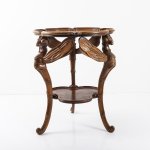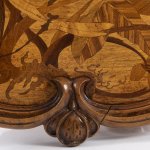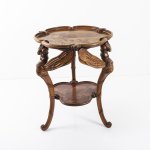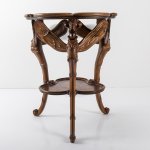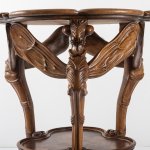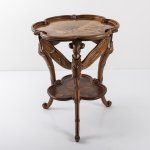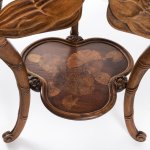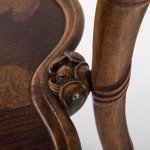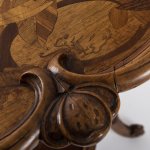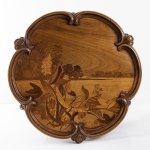Lot: 325
Emile Gallé, Nancy
'Libellules' side table, 1900
Six-sided, slightly concave tabletop with a flying dragonfly in a seascape on three feet in the form of elaborately carved, plastic dragonflies. Fitted second, tripartite plate with water lily decoration. H. 77 cm, Ø 63 cm. Walnut wood, marquetry in different timbers. Signed: E. Gallé with Cross of Lorraine (inlaid).
Design for the Paris World Fair in 1900.
Hammer Price: 28,000 €
11. May 2022 at 3:00 PM CEST
Literature:
Emile Gallé is particularly well-known today for his beautiful, luminous glass vases, which the passionate botanist and chemist made together with a team of highly talented employees, using various techniques and levels of difficulty. Like many of his contemporaries, he drew inspiration for his work from the art of Japan, which was just beginning to spread to the rest of the world. Already in his father's ceramic manufactory he created outstanding decorations with an East Asian influence. Around 1885 he began producing furniture, for which Lorraine, especially Nancy, had been famous beyond the borders of France for centuries. So Gallé had no trouble finding carpenters who could produce to his specifications. On August 3, 2014, Frédéric Le Quer wrote in his article 'Emile Gallé (1846-1904), l'ébéniste' about the present table: “Le guéridon aux 3 libellules vers 1900 est un bel exemple de cette production sculptée avec marqueterie en bois précieux où la forme de l'insecte est intensifiée jusqu'à la limite du grotesque." ("The pedestal table with three dragonflies around 1900 is a fine example of this sculptural execution with precious wood inlays, in which the form of the insect is pushed to the limit of the grotesque.”) https://politiqart.com/emile-galle-lebeniste/ Duncan, The Paris Salons Vol. III, Woodbridge 1996, p. 225; Cat. Nancy 1900, Munich City Museum, Mainz 1980, p. 312f.
Read our Terms & Conditions.










